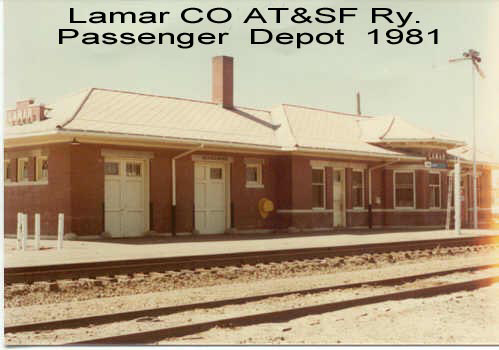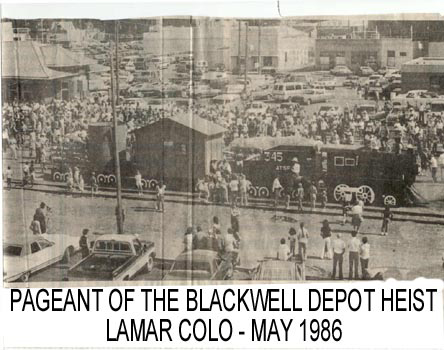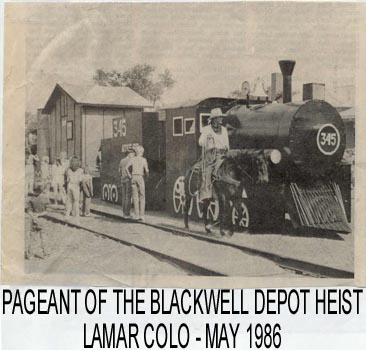LAMAR COLORADO
|
|
(Excerpts of stories by Ava Betz, and C. V. Mills, of Lamar (CO) Daily News used in the Centennial Edition of May 19-23, 1986) Also James Marshal in "Santa Fe, the Railroad that Built an Empire", published by Random House in 1945. Also Milepost locations by Larry R. Green - greenlr@juno.com When the Santa Fe came to Colorado in 1873, generally following the course of the Arkansas River, all of the land it crossed, east of Pueblo County was named Bent County with county seat in Las Animas, 70 miles west of the state line. The only other towns besides Las Animas, were State Line City (later Sargent, then Trail City), and Old Granada near the river, and Sheridan Lake about 30 miles north of Old Granada. This county was about 110 miles east to west, and 70 miles north to south, or about 7,700 square miles. Among the ranchers in the county, was Amos R Black who had a large spread west of Old Granada on both sides of the trackage, an area well suited for cattle with rich grassland on the south, and the Arkansas River with its water, and forest of cottonwood and plum trees for winter refuge on the north. His headquarters was three miles east of the present Lamar, at a siding called Blackwell, established in 1876, bearing the milepost number of 499.2, the distance in miles from Topeka. The railroad placed a wooden two story depot there, along with a water tank, privies, storage sheds, and stock yard for loading and unloading of cattle. Black's ranch foreman, J. A. McDowell and his family lived on the second floor, and the bottom floor served as an office for railroad business. Blackwell was named by using "Black" and "well" for McDowell. Mrs. McDowell was the station agent, and U. S. postmistress. The Santa Fe Land Company knew the railroad's financial existence depended on income derived from new settlers and their growing towns. Early in 1886, Mr. Black was approached to make available some of his lands adjacent to Blackwell as a town site, whereupon he would profit from the sale of the town lots. Black was a tall, fine looking man of forceful character, and true to his calling as a cattleman of the old west. To his mind, the land was cattle country, and he had little patience with farming homesteaders; their fences; their need for towns for support, and would not sell his land. The railroad threatened to start a town three miles west of him, and to move the depot to that spot, much to the displeasure of Mr. Black, who was not above using his men and guns to enforce his will when needed. The depot was railroad owned, but after ten years of serving both as post office and shipping point for Black, he considered it to be part of his domain. The owner of section 31 (name unknown), three miles west of Blackwell, subsequently provided land for a town site which was named Lamar, after Lucius Quintinus Lamar, Secretary of Interior, under President Grover Cleveland. On Saturday May 22, 1886, Black received a telegram urgently demanding his presence in Pueblo, some 125 miles west of Blackwell. He took the last train west. After dusk, a railroad work train left La Junta pulled by Engine 345 in command of Santa Fe Superintendent Ed Marshall, and construction chief R. A. Steen and arrived at Blackwell about midnight. Aboard the train was every available man in the area, hired for a job paying $10.00 each, and all the beer and whiskey he could drink at a big dance and supper in Lamar when the work was done.
Shortly after 12:01 a.m., when legal matters could not be accomplished on a Sunday, the men poured out of the cars with shovels, picks, jacks and blocks. The McDowell family and their belongings was bundled out of the home, with strenuous objections by McDowell, and the building was loaded onto a flat car, using two crane derricks, one on each end. The crew also loaded the water tank, along with out buildings, cattle loading facilities, and whatever equipment that was needed, and the train slowly moved back into Lamar (MP 502) with men walking alongside the track steadying the building. This was no small feat, walking in the dark through the sharp spines of yucca, and prickly pear cactus, as well as watching for those slimy critters of the dark. Also holes from the multitude of prairie dog towns were good for sprained ankles or broken legs for the unwary. Considering that end-of-rail towns were constantly established, and later abandoned, moving small depots to where they were better utilized was not unusual, as the trackage progressed westward. At Lamar the depot and all of its facilities was unloaded through the night, and a siding was constructed to allow the necessary switching of rolling stock from six more work trains sent from La Junta laden with more laborers to assist in the work. The siding was also necessary for the future unloading of the many freight cars carrying supplies and emigrants for the new town. When Black returned home on Sunday he found the train stopping at his familiar depot, but in an unfamiliar setting. The sign originally reading Blackwell, now read Lamar. He looked around a few minutes, then drew his six shooter and demanded to know who was responsible for moving the building. No one owned up to the deed, so after a bit of flustering he made his way back to his ranch. Even more disgusting to him was the makeshift shanties springing up on the prairie. The only carpenters available were those with a hand saw and a hammer, and very little expertise in construction of a building. Siding of buildings was rough boards, with many a crack between. It usually took two only days to complete a building. Tents were commonly used as businesses, including one rooming house, operated by Mrs. Stokes. Real estate people were selling town lots, and the incessant pounding of stakes for property lines and streets. Main street was established for the business houses, but the first inhabitants were prairie dogs running to and fro. However it was not long until commerce began in earnest. Land prices were ranging from $1.50 to $8.00 per acre, and credit was available at 7 percent interest or a 20 percent deduction allowed for cash. An old familiar way of life, was giving way to progress. In 1874, one year after crossing the Kansas-Colorado Line, 6,000 tourists rode the AT&SF Railway Company to the Rockies. Likewise, settlers looking for new land were daily travelers, and the agents of the Santa Fe Land Company were more than willing to help them find a new home. Emigrants using the railroad would load themselves and all of their belongings, including livestock, into however many box cars were needed, for the trip. The best place in the train was directly behind the engine, where there were less jerks and jolts from the slack running through the train in motion, as well as starting and stopping. In railroad jargon these cars were called Zulu's, meaning of which has never been determined. In order to secure the desired train location, the wise emigrant would provide a jug of liquid refreshment for the train crew. When such a present was given, the cars was chalk marked with "Zulu-Jug". If no jug was offered, it was "Zulu-no jug", and placement in the train could be anywhere. Monday morning, May 24, the day's first regularly scheduled train stopped in front of the Lamar station depot, so new that it was even without a foundation. A work train went back to Blackwell on Monday in full daylight to get the foundation stones which had been left behind, much to the chagrin of Black's armed men who protested loudly, but finally relented. A year later, McDowell quit the ranch and moved his family to Lamar, and became one of the pioneer families of the new community. The station served Lamar well for almost two years, then in the early morning hours of March 18, 1888 the newly formed Lamar volunteer fire brigade was brought out to answer an alarm. The building was burned to the ground, apparently by tramps attempting to keep warm. By June 1888 a new wooden depot was in place, corner of Main and Beech street. It was 107 feet long, and 24 feet wide, and the outside was the usual "board and batten" type of siding. In 1902 a ground level brick platform was added. On January 18, 1906 the Lamar Sparks reported rumors of a handsome brick passenger depot to be built. Santa Fe Superintendent Ayer confirmed the rumor, and the depot was scheduled to be built in three months. However, on July 12, the Santa Fe reported a delay since there was not enough common labor available, but did install a 7000 foot siding, and several new tracks in the expanding rail yards. On January 16, 1907 another interesting thing happened, that is not well known. The Lamar Sparks described it this way: "As the culmination of a dispute which has waged since last spring between the Santa Fe Railroad and Prowers County over the payment of taxes assessed to the railroad company, County Treasurer John T. Adkins issued a distraint warrant against the railroad company yesterday to Sheriff Thomas, and last night the sheriff levied on two engines of the company at work in the local yards, placing them in charge of custodians on a spur near the depot. The move proved effective, for this morning the treasurer received a telegram from the superintendent of the road stating that all the taxes would be paid at once, under protest, if the county would release the engines. Accordingly they were returned to the custody of the regular engine crews by the treasurer. The Santa Fe objected last spring to the amount of taxes assessed against it in this county, claiming it was discriminated against heavily in comparison with the values fixed on all agricultural lands. The company made a tender of the amount it felt to be proper to pay, and this was refused by the treasurer. Since then the taxes became delinquent and the treasurer proceeded in the manner stated. The total amount involved is about $30,000. The procedure followed to bring the railroad company to time with its taxes is the one suggested when the dispute first arose. It compels the company to become the plaintiff in court proceedings and throws on it the responsibility of presenting the burden of proof. The only difference is the advice of the Sparks was free, while the county pays Judge Northcutt $1,000 for his time to do the same thing." On August 2, Station Agent G. J. Garvin announced in the Sparks that $10,000.00 was budgeted for the new depot, to be built on the south side of the main line, which was reported as complete on March 7, 1907, however was not ready for business until May 9, when ticket agent Ed Hertzog began selling the first train tickets. 
The old wooden depot then became the freight depot, and remained so until September 1979 when it was razed. It was in this building, I began my railroad clerical career on August 9, 1944. For that story, see SANTA FE - LAMAR COLORADO |









